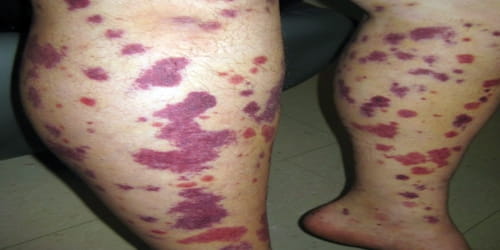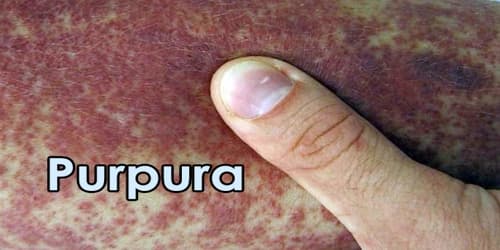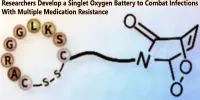Purpura
Definition: Purpura, also called blood spots or skin hemorrhages refers to purple-colored spots that are most recognizable on the skin. The spots may also appear on organs or mucous membranes, including the membranes on the inside of the mouth. It occurs when small blood vessels burst, causing blood to pool under the skin.
Other terms for purpura may be ‘blood spots’ or ‘skin hemorrhages’ – these names provide some clues as to what causes these blotches to occur in the first place.
Purpura spots are generally benign but may indicate a more serious medical condition, such as a blood clotting disorder. The spots are caused by bleeding underneath the skin secondary to platelet disorders, vascular disorders, coagulation disorders, or other causes. They measure 0.3–1 cm (3–10 mm), whereas petechiae measure less than 3 mm, and ecchymoses greater than 1 cm.
Purpura is common with typhus and can be present with meningitis caused by meningococci or septicemia. In particular, meningococcus (Neisseria meningitidis), a Gram-negative diplococcus organism, releases endotoxin when it lyses. Endotoxin activates the Hageman factor (clotting factor XII), which causes disseminated intravascular coagulation (DIC).

Causes, Sign, and Symptom of Purpura: Purpura is caused by blood vessels bursting close to the skin’s surface and blood pools, making spots visible externally. There are two types of purpura: nonthrombocytopenic and thrombocytopenic purpura.
The following could cause nonthrombocytopenic purpura:
- disorders that affect blood clotting
- certain congenital disorders, present at or before birth, such as telangiectasia (fragile skin and connective tissue) or Ehlers-Danlos syndrome
- certain medications, including steroids and those that affect platelet function
- weak blood vessels
- inflammation in the blood vessels
- scurvy, or a severe lack of vitamin C
The following could cause thrombocytopenic purpura:
- medications that prevent platelets from forming or that interfere with normal clotting
- drugs that cause the body to launch an immune reaction against platelets
- recent blood transfusions
- immune disorders such as idiopathic thrombocytopenic purpura
- an infection in the bloodstream
- infection by HIV or Hepatitis C, or some viral infections (Epstein-Barr, rubella, cytomegalovirus)
- Rocky Mountain spotted fever (from a tick bite)
- systemic lupus erythematosus
The specific causes of purpura can be different based on which type of purpura the patient has.
The main symptom of purpura is a purplish-red rash just beneath the skin’s surface. The rash can appear anywhere on the body, including on mucous membranes such as the lining of the mouth. The symptoms that sometimes accompany purpura can help identify its cause.
Patients who experience purpura with any of the following symptoms should seek medical treatment:
- Low platelet count, which may lead to increased bleeding after an injury, bleeding gums or nose, or blood in urine or bowel movements.
- Sore, swollen joints, particularly in the ankles and knees.
- Gut problems such as nausea, vomiting, diarrhea, or stomach pain.
- Kidney problems, particularly protein or blood in the urine.
- Excessive tiredness.
The word purpura (/ˈpɜːrpɜːrə/) comes from Latin purpura, “purple”, which came from ancient Greek πορφύρα. Purpura is a mass noun naming the condition or state, not the name of an individual spot (thus there is no *pupurum, *purpura or *purpura, *purpurae count declension).

Diagnosis and Treatment of Purpura: The doctor will examine the patient’s skin to diagnose purpura. They may ask about the patient’s family and personal health history, such as when the spots first appeared. The doctor may also perform a biopsy of the skin in addition to blood and platelet count tests.
Purpura can affect both children and adults. Children may develop it after a viral infection and can usually recover completely without any intervention. Most children with thrombocytopenic purpura fully recover within several months of the disorder’s onset. However, in adults, the causes of purpura are usually chronic and require treatment to help manage symptoms and keep platelet counts within a healthy range.
Doctors may also perform other tests based on the patient’s symptoms and the suspected diagnosis.
Not all cases of purpura demand immediate treatment. Doctors often opt to watch the patient for other symptoms to see if they go away on their own. Children experiencing Henoch-Schönlein purpura are often likely to get better without treatment.
When treatment is necessary, it is not due to the rash itself. Treatment is needed for causes such as leukemia, or effects including kidney failure.
Doctors may recommend non-steroidal anti-inflammatory drugs (NSAIDS) to reduce inflammation and pain. Steroid treatment can reduce kidney damage and abdominal pain. If kidney damage is severe, doctors may prescribe drugs to suppress the immune system.
Lifestyle treatments can also help since drugs such as aspirin prevent platelets from aggregating and clotting.
When purpura is caused by a medical condition that cannot be cured, ongoing checking of platelet levels and organ functioning may be necessary.
Information Source:
















